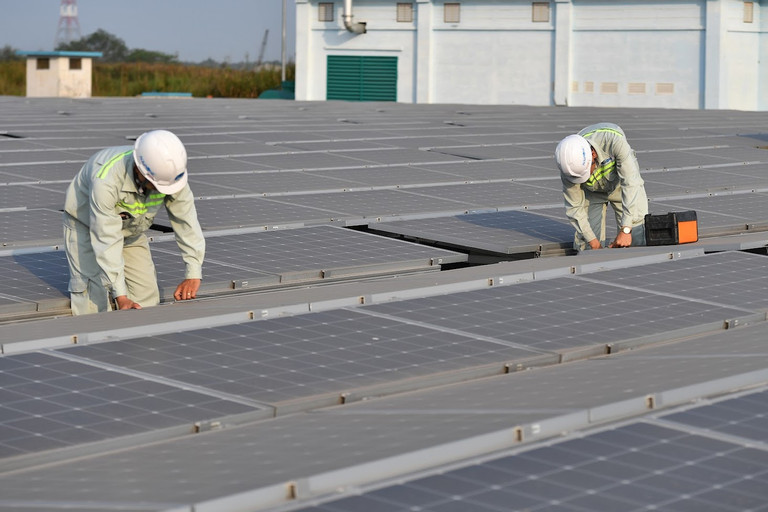
The most noteworthy feature of the draft is that institutions and individuals installing rooftop power systems can only use electricity for themselves, but are not allowed to sell electricity to other institutions and individuals.
There are only two options for the owners of rooftop solar power systems – either consume the entire electricity output they produce, or provide excess electricity to the national grid. But if they choose the latter, they won’t get paid for the electricity.
If this comes true, the market mechanism won’t be applied to enterprises and people who invest to develop rooftop solar power sources. This means that the important source of power won’t be able to contribute to implementing Vietnam’s commitment at COP26 on reducing net emissions to zero percent by 2050.
The Ministry of Industry and Trade (MOIT), which is going to make such a proposal, explained that rooftop solar power system owners cannot run their systems in accordance with market economy rules (selling electricity to those who have demand, and to Electricity of Vietnam - EVN) because there is still no legal framework on this.
Moreover, ‘self-produced’ and ‘self-consumed’ electricity is not mentioned in the Law on Electricity, or is not subject to power source development. Self-sufficiency will make it easier to manage and control electricity generation sources.
Previously, investors could consume rooftop power themselves or sell to non-EVN consumers, provided that both the sources and load were not linked with the national grid. Rooftop solar power was also once prioritized.
However, to defend its view, the draft compiler said the tentative regulation on not selling electricity to other institutions and individuals originated from Decision 13/2020 on the policy to encourage the development of solar power in Vietnam.
The legal document says since January 1, 2021, EVN wouldn’t sign power purchase agreements (PPAs) with the rooftop solar power sources to begin generating electricity after December 31, 2020. The reason was that there was no legal foundation to implement agreements on connecting the national grid.
The explanation has raised a lot of questions. Which agency gave advice to the Prime Minister on the document? Why can’t relevant agencies determine the electricity prices of many solar and wind power sources?
The northern and central regions suffered from a serious electricity shortage this summer. Meanwhile, 4,700MW of solar and wind power could not be provided to the national grid. The clean power sources have a capacity three times higher than the Hoa Binh hydropower plant.
According to MOIT, since there is no legal document with detailed regulations on self-produced and self-consumed solar power, there is not sufficient legal basis for the ministry to build and implement new policies.
Analysts say that the watchdog agency needs to fix the bottlenecks in Decision 13 to encourage the investment, production and supply of clean power, instead of referring to unreasonable articles to continue to set other unreasonable regulations on rooftop solar power development.
Under the eighth national power development plan (Plan 8) which has been approved recently, 50 percent of office buildings and 50 percent of households would use rooftop solar power by 2030.
Meanwhile, according to Dao Xuan Lai from UNDP (the United Nations Development Programme), in order to implement the commitments made at COP28 and reach the goals set in Plan 8 (zero emissions), Vietnam would need capital of $134.5 billion to develop electricity generation sources by 2030.
In such conditions, it is necessary to set policies to solve problems related to the scheme on excessive power purchase from businesses and households, because this will help ease pressure on the state in developing renewable power sources.
If households and businesses can sell electricity from their solar power systems, they will get extra income, and the electricity shortage will be eased.
Reasonable policies to ensure the smooth operation of the electricity market are necessary. To date, only 20 percent of the potential for rooftop solar power has been exploited.
Nguyen Huy Vien